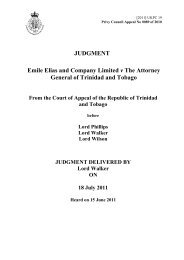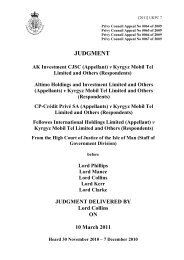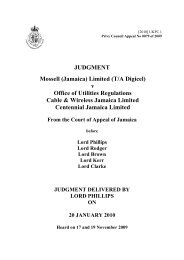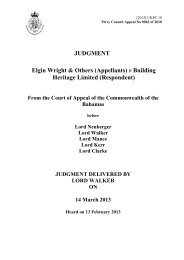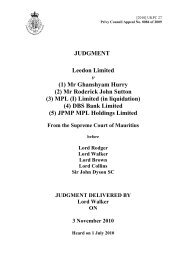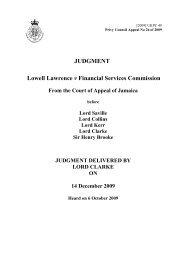Terrell Neilly v The Queen - Judicial Committee of the Privy Council
Terrell Neilly v The Queen - Judicial Committee of the Privy Council
Terrell Neilly v The Queen - Judicial Committee of the Privy Council
You also want an ePaper? Increase the reach of your titles
YUMPU automatically turns print PDFs into web optimized ePapers that Google loves.
29. Issues as to <strong>the</strong> quality <strong>of</strong> a witness’s observation <strong>of</strong> an <strong>of</strong>fender, <strong>of</strong> <strong>the</strong> kind<br />
addressed in Turnbull, are relevant to dock identifications. In <strong>the</strong> case <strong>of</strong> dock<br />
identifications, however, <strong>the</strong>re is an added and separate need for caution, arising from<br />
<strong>the</strong> circumstances inherent in dock identification. <strong>The</strong> purpose <strong>of</strong> an identification<br />
parade is “to ensure that <strong>the</strong> identification <strong>of</strong> a suspect by a witness takes place in<br />
circumstances where <strong>the</strong> recollection <strong>of</strong> <strong>the</strong> identifying witness is tested objectively<br />
under safeguards by placing <strong>the</strong> suspect in a line made up <strong>of</strong> like-looking suspects”<br />
(Myvett and Santos v <strong>The</strong> <strong>Queen</strong> (unreported) 9 May 1994, Criminal Appeals Nos 3<br />
and 4 <strong>of</strong> 1994), cited in Pop v <strong>The</strong> <strong>Queen</strong> [2003] UKPC 40, in turn cited in<br />
Pipersburgh v <strong>The</strong> <strong>Queen</strong> [2008] UKPC 11, para 9.) <strong>The</strong> benefits <strong>of</strong> an identification<br />
parade and <strong>the</strong> weaknesses <strong>of</strong> a dock identification were summarised in Holland v HM<br />
Advocate [2005] UKPC D1, 2005 SC (PC) 1, 17, para 47:<br />
“…identification parades <strong>of</strong>fer safeguards which are not available when<br />
<strong>the</strong> witness is asked to identify <strong>the</strong> accused in <strong>the</strong> dock at his trial. An<br />
identification parade is usually held much nearer <strong>the</strong> time <strong>of</strong> <strong>the</strong> <strong>of</strong>fence<br />
when <strong>the</strong> witness’s recollection is fresher. Moreover, placing <strong>the</strong><br />
accused among a number <strong>of</strong> stand-ins <strong>of</strong> generally similar appearance<br />
provides a check on <strong>the</strong> accuracy <strong>of</strong> <strong>the</strong> witness’s identification by<br />
reducing <strong>the</strong> risk that <strong>the</strong> witness is simply picking out someone who<br />
resembles <strong>the</strong> perpetrator. Similarly, <strong>the</strong> Advocate-depute did not<br />
gainsay <strong>the</strong> positive disadvantages <strong>of</strong> an identification carried out when<br />
<strong>the</strong> accused is sitting in <strong>the</strong> dock between security guards: <strong>the</strong><br />
implication that <strong>the</strong> prosecution is asserting that he is <strong>the</strong> perpetrator is<br />
plain for all to see. When a witness is invited to identify <strong>the</strong> perpetrator<br />
in court, <strong>the</strong>re must be a considerable risk that his evidence will be<br />
influenced by seeing <strong>the</strong> accused sitting in <strong>the</strong> dock in this way. So a<br />
dock identification can be criticised in two complementary respects: not<br />
only does it lack <strong>the</strong> safeguards that are <strong>of</strong>fered by an identification<br />
parade, but <strong>the</strong> accused’s position in <strong>the</strong> dock positively increases <strong>the</strong><br />
risk <strong>of</strong> a wrong identification.”<br />
30. It follows that <strong>the</strong> fact that <strong>the</strong> circumstances <strong>of</strong> a witness’s identification <strong>of</strong> a<br />
person were such as to enable him to make a reliable identification in an identification<br />
parade does not render a dock identification by <strong>the</strong> witness reliable. As was pointed<br />
out by <strong>the</strong> Board in Pipersburgh at [15], <strong>the</strong> issues as to <strong>the</strong> sufficiency <strong>of</strong> a witness’s<br />
observation <strong>of</strong> a suspect are different from those as to <strong>the</strong> reliability <strong>of</strong> a dock<br />
identification.<br />
31. It fur<strong>the</strong>r follows that <strong>the</strong> normal and proper practice should be to hold an<br />
identification parade, and that in any case where a dock identification is admitted <strong>the</strong><br />
judge should warn <strong>the</strong> jury <strong>of</strong> <strong>the</strong> undesirability in principle and dangers <strong>of</strong> a dock<br />
identification and give fur<strong>the</strong>r directions along lines set out in Aurelio Pop v <strong>The</strong><br />
<strong>Queen</strong> [2003] UKPC 40, para 9, Pipersburgh v <strong>The</strong> <strong>Queen</strong> [2008] UKPC 11, para 9<br />
Page 9


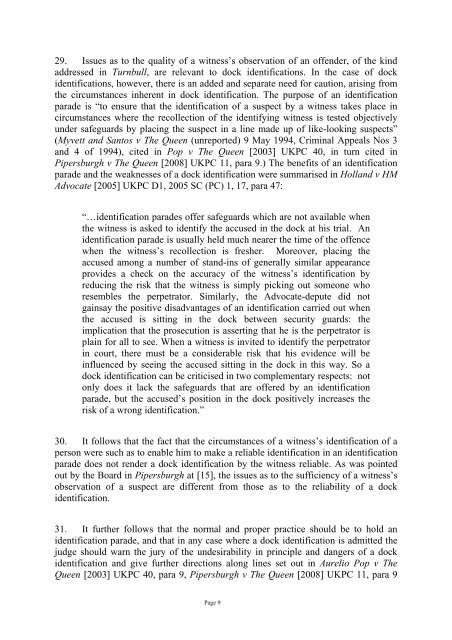
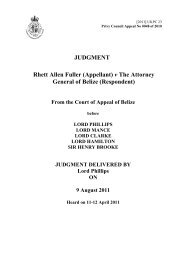

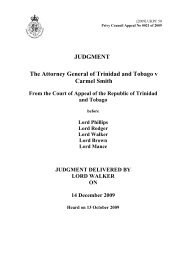
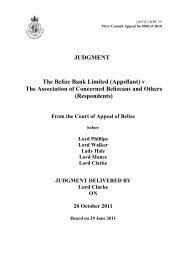
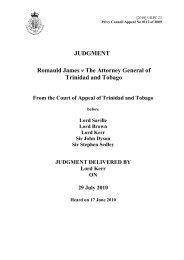
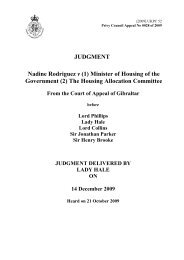
![[2011] UKPC 10 - Judicial Committee of the Privy Council](https://img.yumpu.com/23644185/1/184x260/2011-ukpc-10-judicial-committee-of-the-privy-council.jpg?quality=85)
